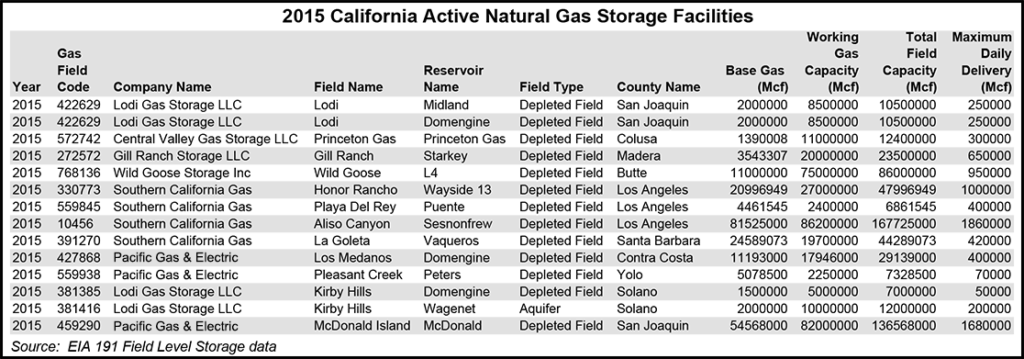Markets | NGI All News Access | NGI The Weekly Gas Market Report
California Survey: Leaks In All But One of Dozen Storage Fields
Some 229 leaks were found in California’s 12 underground natural gas storage fields in a recent survey, but all but a handful were minor and nearly all of them were repaired by the time the survey results were released recently. Non-utility run Lodi Storage in Northern California was the only one found to be leak free.

The California Public Utilities Commission (CPUC) conducted the survey in the aftermath of the four-month-long storage well leak at Southern California Gas Co.’s (SoCalGas) Aliso Canyon storage facility in Los Angeles, which was permanently sealed last month (see Daily GPI, Feb. 18). Sixty-six of the leaks detected in the February statewide survey were found at the 3,600-acre Aliso site, which is the state’s largest gas storage facility.
Pacific Gas and Electric Co. (PG&E) has three storage facilities in Northern California, at which 84 leaks were detected. The San Francisco-based combination utility said all the leaks had been identified before the survey. Eight of the survey leaks classified as hazardous were found at the PG&E facilities with six of them being fixed by the time the survey report was published.
Officials at the Division of Oil, Gas and Geothermal Resources (DOGGR) have committed to reducing leaks, and the new requirements for daily inspections will help fulfill that commitment, a DOGGR spokesperson told NGI.
CPUC’s Safety and Enforcement Division (SED) in late January directed all of the state’s gas storage facility operators to inspect for leaks and report their findings to SED in February. SED used federal criteria in reviewing the results and assuming that all identified leaks were repaired or in the process of repair, a report on the CPUC website said.
The vast majority (95%, or 218) of the leaks reported between Oct. 26 and Feb. 5 were “non-hazardous and required minor responses, such as tightening or lubricating valves,” the CPUC said. None of the 22 leaks now still being repaired are at SoCalGas’ Aliso Canyon facility; they are in Northern California on PG&E’s and non-utility storage sites.
DOGGR and the California Air Resources Board (CARB) will work to refine inspection requirements, the CPUC said.
“Our legal office has advised us that there are regulatory overlaps between DOGGR and CPUC authority on natural gas storage fields, and both state and local air boards [also] can become involved when there are leaks,” a DOGGR spokesperson said. CARB reportedly now is working on requirements for equipment in the storage fields to be checked for leaks every three months.
The CPUC reiterated that under current federal regulations gas storage facility operators monitor their own facilities for gas leaks, and SED oversees compliance with the federal pipeline safety regulations. CARB is addressing equipment leaks. In addition, the CPUC is studying whether additional leak survey requirements are necessary in the transmission/distribution pipeline sector.
The state uses the federal criteria for rating leaks as grades one through three (G1-3) with G1 being hazardous and requiring immediate attention; G2, nonhazardous but needing to be scheduled for repair; and G3 nonhazardous with no immediacy required in the repair scheduling.
Of the 66 leaks noted at Aliso Canyon, the CPUC reported that all were repaired and all were of a “minor, nonhazardous” variety. In its submittal to the CPUC, SoCalGas said the leak assessment only related to active wells and equipment; it did not include naturally occurring leaks of gas or abandoned wells, and the utility said facilities with one existing non-hazardous leak are currently in the process of abandonment under DOGGR’s oversight.
“All leaks found were on above-ground equipment, were non-hazardous, and did not pose a threat to safety or the environment,” said Michael Thorp, SoCalGas chief regulatory counsel.
© 2024 Natural Gas Intelligence. All rights reserved.
ISSN © 1532-1231 | ISSN © 2577-9877 | ISSN © 1532-1266 |
